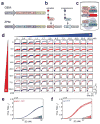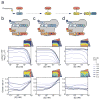Robust Synthetic Circuits for Two-Dimensional Control of Gene Expression in Yeast
- PMID: 27930885
- PMCID: PMC5507677
- DOI: 10.1021/acssynbio.6b00251
Robust Synthetic Circuits for Two-Dimensional Control of Gene Expression in Yeast
Abstract
Cellular phenotypes are the result of complex interactions between many components. Understanding and predicting the system level properties of the resulting networks requires the development of perturbation tools that can simultaneously and independently modulate multiple cellular variables. Here, we develop synthetic modules that use different arrangements of two transcriptional regulators to achieve either concurrent and independent control of the expression of two genes, or decoupled control of the mean and variance of a single gene. These modules constitute powerful tools to probe the quantitative attributes of network wiring and function.
Keywords: control; mating pathway; noise; orthogonal; sic1.
Conflict of interest statement
The authors declare no competing financial interest.
Figures




References
-
- Schuldiner M, et al. Exploration of the function and organization of the yeast early secretory pathway through an epistatic miniarray profile. Cell. 2005;123:507–19. - PubMed
-
- Louvion JF, Havaux-Copf B, Picard D. Fusion of GAL4-VP16 to a steroid-binding domain provides a tool for gratuitous induction of galactose-responsive genes in yeast. Gene. 1993;131:129–134. - PubMed
MeSH terms
Grants and funding
LinkOut - more resources
Full Text Sources
Other Literature Sources
Molecular Biology Databases
Research Materials

